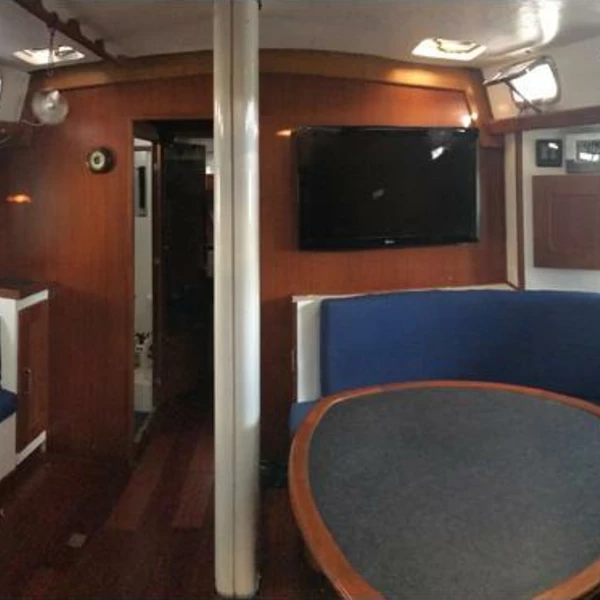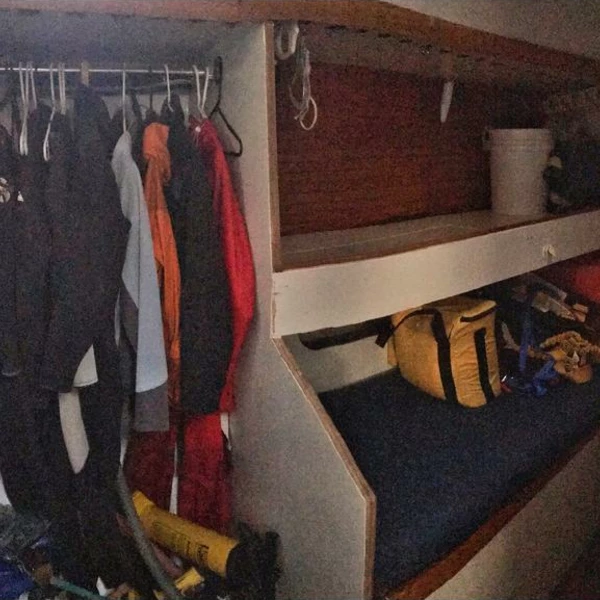Seller's Description
Sail away at a safe distance in a large spacious sloop in paradise! Very comfortable (close to 7 feet headroom) sailing yacht. Weve spent the past three years re-fitting with a turbo diesel engine, new electrical and the latest and greatest modern electronic navigational equipment. This vessel was built with a strong, thick hull. She draws just 510 with a displacement of 37,500 pounds. A stable and fast cruiser with a great layout. The galley is large, there are two heads, and three cabins. Aft helm under the large solar arch plus a center cockpit. Forward and aft cabins each have queen-sized beds. The mid-cabin has two berths in bunk beds. Gear storage and thought-out comforts for cruising are plentiful. This sailboat is set up to island hop, cross oceans or live-aboard on the hook. Make your own water and power and live comfortably.
We spent three years refitting this sailboat and we have photos and videos to share so you can see the work that was done.
It takes two people to sail this vessel and you can sleep eight or more if you want.
We are new sailors and so we put a lot of emphasis on safety and reliability in our refit. We refitted this boat to sail the world, and we’ve since moved to an island and taken on a huge project that sadly leaves us no time for sailing. So we’re ready to pass this dream on to the next people. If you want a strong sailboat with some cosmetic work to do but nearly all the heavy boat refitting work done already, this is the boat for you. And if youve been considering a smaller sailboat youre going to love all the space on this boat. For live-aboard cruising theres space for you and guests or crew. Space to charter if you desire. And ready to go anywhere you want.
Located in the U.S. Virgin Islands (we sailed here from Florida). You don’t need a passport to get here. This is the best location to start a sailing voyage. Great island hopping. Clear, warm water. And gorgeous beaches.
Equipment: 51’ overall (actually a bit more with the integrated dinghy davits and solar arch) Three cabins, two heads Interior ceiling clearance is about 6’8”! Tall people welcome! Fiberglass hull with a lead wing keel Draft is 5’10” Beam is 15’ 65’ clearance (tall rig) 100 h.p. Yanmar turbo diesel engine (remanufactured) with less than 400 hours. Aft helm, center cockpit. Sloop rigged with stainless rigging and Norseman fittings. Lofrans horizontal windlass with gypsy Rocna 40kg (88pound) galvanized anchor plus spare anchors Solar Arch with three solar panels and a wind turbine Integrated dinghy davits can lift dinghy with outboard together. Four 8d batteries in separate banks of two batteries each Separate engine starting battery Upgraded and rewired electrical system Galvonic isolator. Fuel polishing system with Racor filter. Spectra watermaker (never used so hasn’t even been pickled). B&G suite of excellent navigational equipment including… 12” B&G chart plotter (WI-FI enabled so you can link you tablet for a mobile screen) B&G 4g radar (integrated and overlaid on the chart plotter) AIS Receiver (integrated and overlaid on the chart plotter) Hydraulic steering B&G autopilot Remote autopilot controller Depth, temperature and speed sensor (B&G Electronic compass (B&G) Windspeed and direction (B&G) Paratech sea anchor Mainsail 130 genoa 110 genoa (backup) Storm jib made by ATN, the Gale Sail - clips over rolled headsail Asymmetrical spinnaker with easy deployment sock Watermaker - Spectra (never been used!) 150 gallons water storage ICOM VHF ICOM M802 SSB long range radio with pactor modem. Wi-Fi extender antennae so you can get wifi from shore while on anchor Epirb with automatic deployment mount Liferaft - six person (out of certification) Flares and flare gun Jacklines. Auto inflate life vests with harnesses and tethers. Lifelines with stanchions that clip into the toe rails and mount to the deck. Dodger and bimini system creates a screened in cockpit (no bugs). Screens for port lights and hatches. Large galley with Gimballed three burner propane stove and oven. Spacious salon with curved settee, table and another long bench seat. Forward cabin has a queen bed with head accessible from cabin or from salon. Aft cabin has a queen bed and en-suite head. Both heads are manual pump with new black water holding tanks and mascerators. Mid cabin has bunk beds (bottom berth could easily be widened). Salon settee (table lowers and additional fitted cushion can be inserted as double berth Engine room has easy access. Automatic fire extinguisher in the engine room Hand-held fire extinguishers Fire blanket in galley Pex piping for fresh water system. Completely replaced exhaust system with a Vernalift 10gallon muffler Stainless hot water heater (engine or 110volt) SCUBA compressor with a Yanmar diesel engine (needs service) - Bauer Capitano SCUBA tank racks Bosuns chair Rocker stoppers New bottom paint and zincs Lightning bonding
Specs
- Designer
- Johan Valentijn
- Builder
- Endeavour Yacht Corp.
- Association
- Endeavour Sailboat Owners
- # Built
- ?
- Hull
- Monohull
- Keel
- Wing
- Rudder
- ?
- Construction
- FG
Dimensions
- Length Overall
- 50′ 11″ / 15.5 m
- Waterline Length
- 42′ 3″ / 12.9 m
- Beam
- 14′ 11″ / 4.6 m
- Draft
- 4′ 11″ / 1.5 m
- Displacement
- 37,000 lb / 16,783 kg
- Ballast
- 17,300 lb / 7,847 kg
Rig and Sails
- Type
- Sloop
- Reported Sail Area
- 1,078′² / 100.2 m²
- Total Sail Area
- 1,078′² / 100.2 m²
Mainsail
- Sail Area
- 454′² / 42.2 m²
- P
- 50′ 5″ / 15.4 m
- E
- 18′ 0″ / 5.5 m
- Air Draft
- ?
Foresail
- Sail Area
- 624′² / 58 m²
- I
- 57′ 6″ / 17.5 m
- J
- 21′ 8″ / 6.6 m
- Forestay Length
- 61′ 5″ / 18.7 m
Auxilary Power
- Make
- Perkiins
- Model
- ?
- HP
- ?
- Fuel Type
- Diesel
- Fuel Capacity
- 160 gal / 606 l
- Engine Hours
- ?
Accomodations
- Water Capacity
- 400 gal / 1,514 l
- Holding Tank Capacity
- ?
- Headroom
- ?
- Cabins
- 3
Calculations
- Hull Speed
-
10.1 kn
Classic: 8.71 kn
Hull Speed
The theoretical maximum speed that a displacement hull can move efficiently through the water is determined by it's waterline length and displacement. It may be unable to reach this speed if the boat is underpowered or heavily loaded, though it may exceed this speed given enough power. Read more.
Formula
Classic hull speed formula:
Hull Speed = 1.34 x √LWL
A more accurate formula devised by Dave Gerr in The Propeller Handbook replaces the Speed/Length ratio constant of 1.34 with a calculation based on the Displacement/Length ratio.
Max Speed/Length ratio = 8.26 ÷ Displacement/Length ratio.311
Hull Speed = Max Speed/Length ratio x √LWL
- Sail Area/Displacement
-
15.5
<16: under powered
Sail Area / Displacement Ratio
A measure of the power of the sails relative to the weight of the boat. The higher the number, the higher the performance, but the harder the boat will be to handle. This ratio is a "non-dimensional" value that facilitates comparisons between boats of different types and sizes. Read more.
Formula
SA/D = SA ÷ (D ÷ 64)2/3
- SA: Sail area in square feet, derived by adding the mainsail area to 100% of the foretriangle area (the lateral area above the deck between the mast and the forestay).
- D: Displacement in pounds.
- Ballast/Displacement
-
46.8
>40: stiffer, more powerful
Ballast / Displacement Ratio
A measure of the stability of a boat's hull that suggests how well a monohull will stand up to its sails. The ballast displacement ratio indicates how much of the weight of a boat is placed for maximum stability against capsizing and is an indicator of stiffness and resistance to capsize.
Formula
Ballast / Displacement * 100
- Displacement/Length
-
218.9
200-300: moderate
Displacement / Length Ratio
A measure of the weight of the boat relative to it's length at the waterline. The higher a boat’s D/L ratio, the more easily it will carry a load and the more comfortable its motion will be. The lower a boat's ratio is, the less power it takes to drive the boat to its nominal hull speed or beyond. Read more.
Formula
D/L = (D ÷ 2240) ÷ (0.01 x LWL)³
- D: Displacement of the boat in pounds.
- LWL: Waterline length in feet
- Comfort Ratio
-
34.3
30-40: moderate bluewater cruising boat
Comfort Ratio
This ratio assess how quickly and abruptly a boat’s hull reacts to waves in a significant seaway, these being the elements of a boat’s motion most likely to cause seasickness. Read more.
Formula
Comfort ratio = D ÷ (.65 x (.7 LWL + .3 LOA) x Beam1.33)
- D: Displacement of the boat in pounds
- LWL: Waterline length in feet
- LOA: Length overall in feet
- Beam: Width of boat at the widest point in feet
- Capsize Screening
-
1.8
<2.0: better suited for ocean passages
Capsize Screening Formula
This formula attempts to indicate whether a given boat might be too wide and light to readily right itself after being overturned in extreme conditions. Read more.
Formula
CSV = Beam ÷ ³√(D / 64)
- Beam: Width of boat at the widest point in feet
- D: Displacement of the boat in pounds
Notes
CSY 51, also built by Endeavour, is similar.
‘Owners’ and ‘Charter’ versions.
Deep keel version:
Draft 7.50’ / 2.29m
Displacement: 34000 lbs./ 15422 kgs.
Tall rig:
I(IG): 65.00’ / 19.81m
J: 21.70’ / 6.61m
P: 57.50’ / 17.53m
E: 18.00’ / 5.49m
This listing is presented by SailboatListings.com. Visit their website for more information or to contact the seller.















